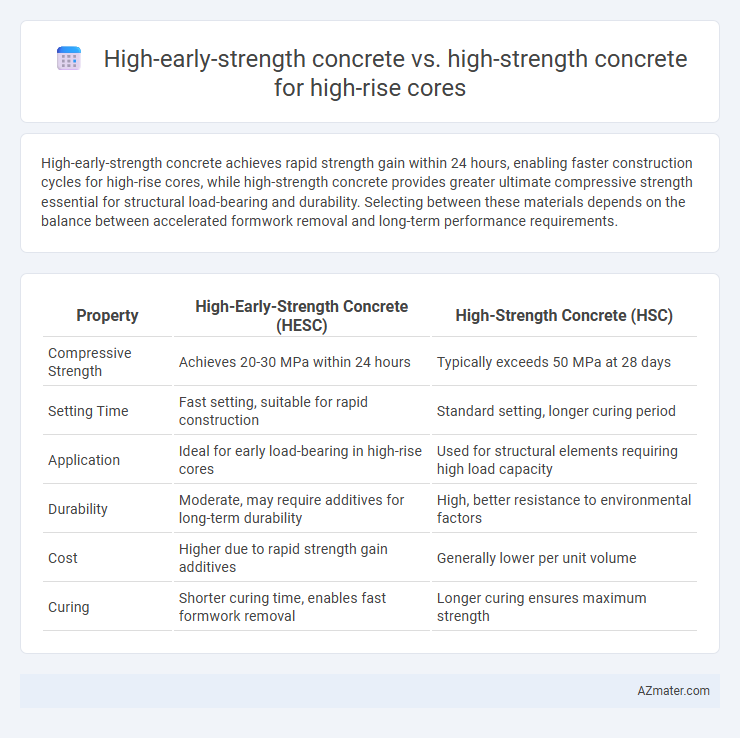High-early-strength concrete achieves rapid strength gain within 24 hours, enabling faster construction cycles for high-rise cores, while high-strength concrete provides greater ultimate compressive strength essential for structural load-bearing and durability. Selecting between these materials depends on the balance between accelerated formwork removal and long-term performance requirements.
Table of Comparison
| Property | High-Early-Strength Concrete (HESC) | High-Strength Concrete (HSC) |
|---|---|---|
| Compressive Strength | Achieves 20-30 MPa within 24 hours | Typically exceeds 50 MPa at 28 days |
| Setting Time | Fast setting, suitable for rapid construction | Standard setting, longer curing period |
| Application | Ideal for early load-bearing in high-rise cores | Used for structural elements requiring high load capacity |
| Durability | Moderate, may require additives for long-term durability | High, better resistance to environmental factors |
| Cost | Higher due to rapid strength gain additives | Generally lower per unit volume |
| Curing | Shorter curing time, enables fast formwork removal | Longer curing ensures maximum strength |
Introduction to High-Rise Core Concrete Requirements
High-rise core concrete demands a balance between early strength gain and long-term durability, crucial for structural stability and timely construction progress. High-early-strength concrete offers rapid load-bearing capacity, minimizing construction delays and formwork cycles, whereas high-strength concrete provides superior compressive strength essential for resisting high lateral and vertical loads. Selecting the appropriate mix depends on project scheduling, load requirements, and safety standards typical of high-rise building cores.
Defining High-Early-Strength Concrete
High-early-strength concrete is characterized by its ability to achieve compressive strengths of 20 MPa (2900 psi) or more within the first 24 hours, enabling faster formwork removal and accelerated construction schedules in high-rise core applications. It typically incorporates higher cement content, specialized admixtures, and optimized curing techniques to enhance early hydration reactions. In contrast, high-strength concrete focuses on ultimate strength, often exceeding 50 MPa (7250 psi) at 28 days, prioritizing long-term load capacity rather than early-age strength development.
Defining High-Strength Concrete
High-strength concrete typically refers to concrete with compressive strength exceeding 6,000 psi (41 MPa) and is engineered for structural applications demanding superior load-bearing capacity, such as high-rise cores. This concrete incorporates low water-to-cement ratios, high-quality aggregates, and supplementary cementitious materials like silica fume or fly ash to enhance durability and reduce permeability. Compared to high-early-strength concrete, which gains strength rapidly within days, high-strength concrete achieves optimal long-term performance essential for the stability and safety of high-rise building cores.
Key Material Properties Comparison
High-early-strength concrete achieves compressive strengths of 20-30 MPa within 24 hours, enabling faster formwork removal and shortened construction cycles in high-rise core applications. In contrast, high-strength concrete typically attains 50-100 MPa at 28 days, offering superior load-bearing capacity and enhanced durability for critical structural elements. Key material properties such as lower water-to-cement ratios and optimized aggregate gradation in high-strength concrete improve mechanical performance and resistance to environmental stressors compared to the rapid-setting, higher cement content composition of high-early-strength concrete.
Setting Time and Construction Speed
High-early-strength concrete typically achieves significant compressive strength within 24 hours, enabling faster formwork removal and accelerated construction speed for high-rise cores compared to conventional high-strength concrete, which requires longer curing times to reach peak strength. High-strength concrete offers superior long-term durability and load-bearing capacity but generally has longer setting times that can slow project timelines. Selecting high-early-strength concrete optimizes the construction schedule by reducing curing duration while maintaining adequate initial strength for vertical load support.
Structural Performance in High-Rise Cores
High-early-strength concrete offers rapid load-bearing capacity essential for accelerating construction schedules in high-rise cores, enabling early formwork removal and reducing overall project duration. High-strength concrete provides superior compressive strength and durability, enhancing the structural integrity and lifespan of tall buildings under significant axial loads and lateral forces. Selecting between these concretes depends on balancing early construction demands with long-term performance criteria in high-rise core structural applications.
Durability and Long-Term Performance
High-early-strength concrete gains strength rapidly within the first 24 hours, enabling faster construction schedules but may exhibit higher shrinkage and creep, potentially impacting the durability of high-rise cores. High-strength concrete, typically exceeding 6000 psi, offers superior compressive performance and enhanced long-term durability due to its dense microstructure, reducing permeability and resistance to environmental aggressors. For high-rise core applications, high-strength concrete ensures prolonged structural integrity and longevity, while high-early-strength concrete favors early load-bearing needs but requires careful mix design to mitigate long-term durability concerns.
Cost Implications for Core Construction
High-early-strength concrete accelerates construction schedules by reducing formwork removal time, which can significantly lower labor and overhead costs in high-rise core construction. High-strength concrete, while offering superior load-bearing capacity, typically requires longer curing periods and higher material costs that may extend the project timeline and increase expenditures. Balancing the initial investment in material costs with the potential savings in construction duration is crucial for optimizing overall cost efficiency in high-rise core projects.
Sustainability and Environmental Impact
High-early-strength concrete enables faster construction cycles, reducing on-site emissions and energy consumption, thereby enhancing sustainability in high-rise core applications. High-strength concrete, characterized by its durable and long-lasting properties, contributes to lower material usage and reduced structural maintenance, minimizing environmental impact over the building's lifecycle. Selecting the appropriate concrete type balances early construction speed with long-term environmental benefits, promoting eco-efficient high-rise development.
Choosing the Right Concrete for High-Rise Cores
High-early-strength concrete accelerates formwork removal and shortens construction cycles, making it ideal for time-sensitive high-rise core projects requiring rapid load-bearing capacity. High-strength concrete, characterized by compressive strengths above 7,000 psi, offers superior durability and structural integrity critical for the vertical loads and lateral forces encountered in tall buildings. Selecting between high-early-strength and high-strength concrete depends on project schedule priorities and structural demands, optimizing core performance and construction efficiency in skyscraper engineering.

Infographic: High-early-strength concrete vs High-strength concrete for High-rise core
 azmater.com
azmater.com